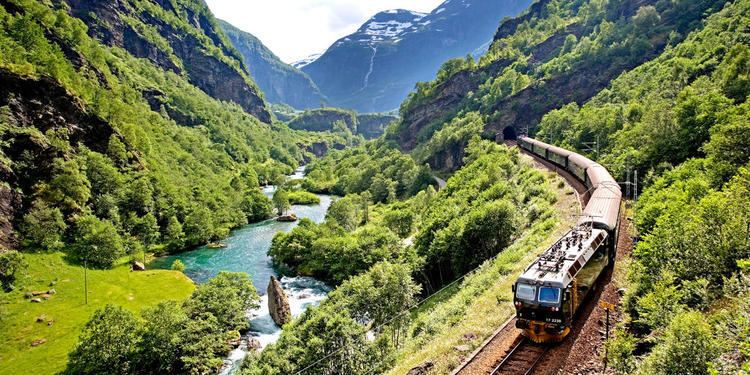Municipality Aurland Elevation 59 m | District Sogn Time zone CET (UTC+01:00) Local time Monday 10:27 PM | |
 | ||
Weather 9°C, Wind W at 14 km/h, 92% Humidity Points of interest Flåm Line, Nærøyfjord, Stalheimsfossen, Rjoandefossen, Flåm Utvikling | ||
Flåm is a village in Flåmsdalen, at the inner end of the Aurlandsfjorden—a branch of Sognefjorden. The village is located in the municipality of Aurland in Sogn og Fjordane county, Norway.
Contents
- Map of 5743 FlC3A5m Norway
- Name
- History
- Population
- Transportation
- Tourism
- Complaints of and suggested curbs on tourism
- People
- References
Map of 5743 Fl%C3%A5m, Norway
Name
The name Flåm is documented as early as 1340 as Flaam. It is derived from the plural dative form of the Old Norse word flá meaning "plain, flat piece of land", and it refers to the flood plains of the Flåm River. ("A plain between steep mountains" is the toponomy of the encyclopedia Store Norske Leksikon.)
History
In 1670 Flåm Church was built.
In 1923 the construction of the Flåm Line was financed by parliament. (In 1908, the decision to build the line was made.)
In 1942 ordinary operation of (steam powered) trains started on the Flåm Line.
"In the 1960s, cruise ships stayed on the fjord" [without reaching the port], according to Dagens Næringsliv.
In 2000, the "new pier" was referred to in a government document. ("The pier was built at the entrance to the new millennium", according to Dagens Næringsliv.)
Population
In 2014 its inhabitants numbered 350.
Transportation
The closest airport is Sogndal Airport, Haukåsen, approximately 70 kilometres from Flåm.
The European route E16 highway between Oslo and Bergen runs through Flåm.
The village is located along the European route E16 highway, about 7 kilometres (4.3 mi) southwest of the municipal centre of Aurlandsvangen, 12 kilometres (7.5 mi) south of the village of Undredal, and 15 kilometres (9.3 mi) east of the village of Gudvangen (through the Gudvanga Tunnel).
The navvy road, Rallarvegen stretches from Myrdal down to Flåm. (Pedestrians and bicyclists still use it.) At Myrdal it connects with the navvy road for the previously built Bergen Line.
Tourism
The village of Flåm has since the late 19th century been a tourist destination. It currently receives almost 450,000 visitors a year. Most ride the 20-kilometre (12 mi) Flåm Line between Flåm and Myrdal, one of the steepest railway tracks at 1 in 18 (not counting rack railways) in the world. There are also a few spirals. A former rail station building in Flåm now houses a museum dedicated to the Flåm railway.
The harbour of Flåm receives some 160 cruise ships per year.
Complaints of- and suggested curbs on tourism
In a 2005 Bergens Tidende article Kjetil Smørås (a hotel director and chairman of Fjord Norge said that "The cruise traffic pollutes more than several ten thousands of cars, and many of the worst ships sail up here (...) cruise tourists trod down the pristine Norwegian nature, and destroy the foundation for Vestlandet's four entries on Unesco's World Heritage lists".
In 2009 Jens Riisnæs (an author and NRK journalist) said "We have the world's most beautiful nation, we don't need to follow cruise operators' premisser. They can go other places with their polluting ships. It is unwanted noise."
In 2009 Dagens Næringsliv said that a report by Vestlandsforskning says that both "Flåm and Geiranger are nearing a limit in capacity. It might be an alternative and rather stand forth as a «relaxed», exclusive and somewhat less of a mass tourism, cruise destination."
In a 2014 Dagens Næringsliv article a farmer said that "Previously the smell of summer was that of grass that had been cut. Now [the smell] it is [of] tungolje" ["heavy-oil"]. Furthermore, "They [a retired couple] talk about fish that has disappeared from the fjord. In Norway cruise ships are permitted to dump overboard their greywater in the postcard-narrow fjord-arms. Furthermore the news article says that defecation in public by tourists, is already a problem; the village has one public toilet, and 200 000 tourists are expected in the summer season.
In 2014 a professor i reiseliv (Arvid Viken) said that "it is about time this [type of] tourism is evalaluated somewhat more soberly, than the evaluations done in many municipalities for some years". Furthermore, this tourism "has low profit per tourist, but often it is associated with considerable costs for" the municipal administrations.
People
Flåm was the birthplace of the poet Per Sivle.
